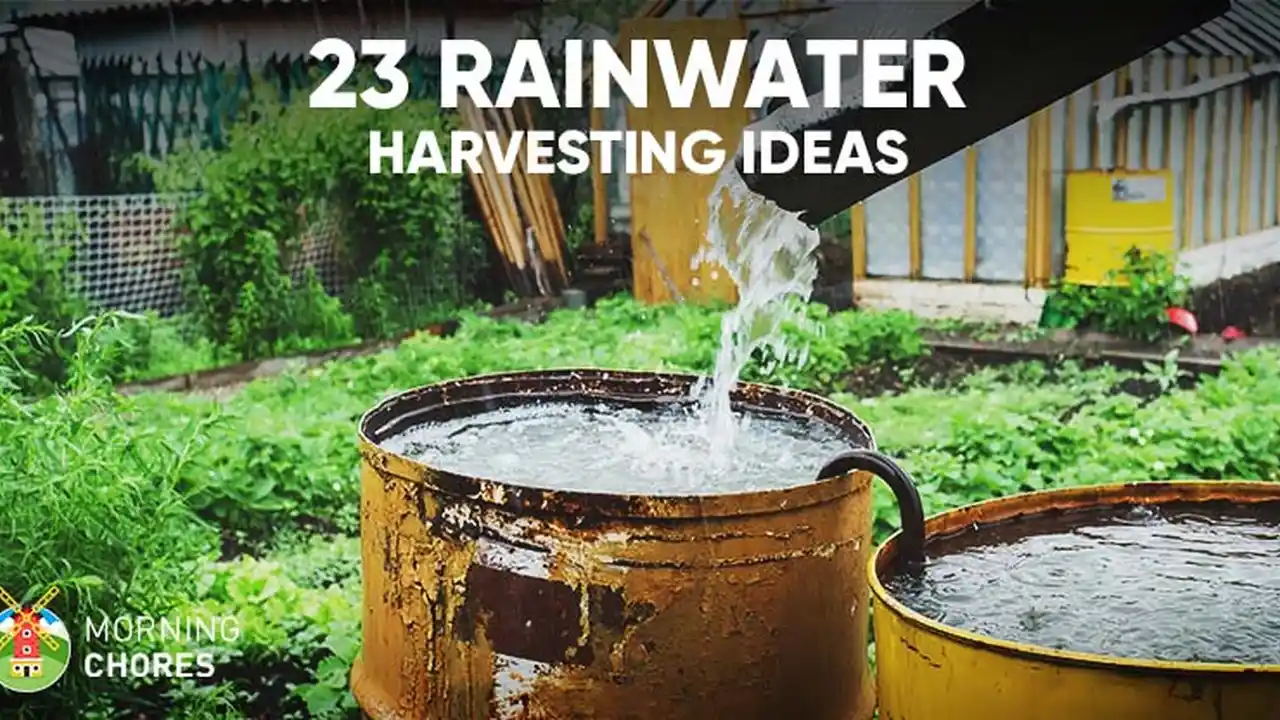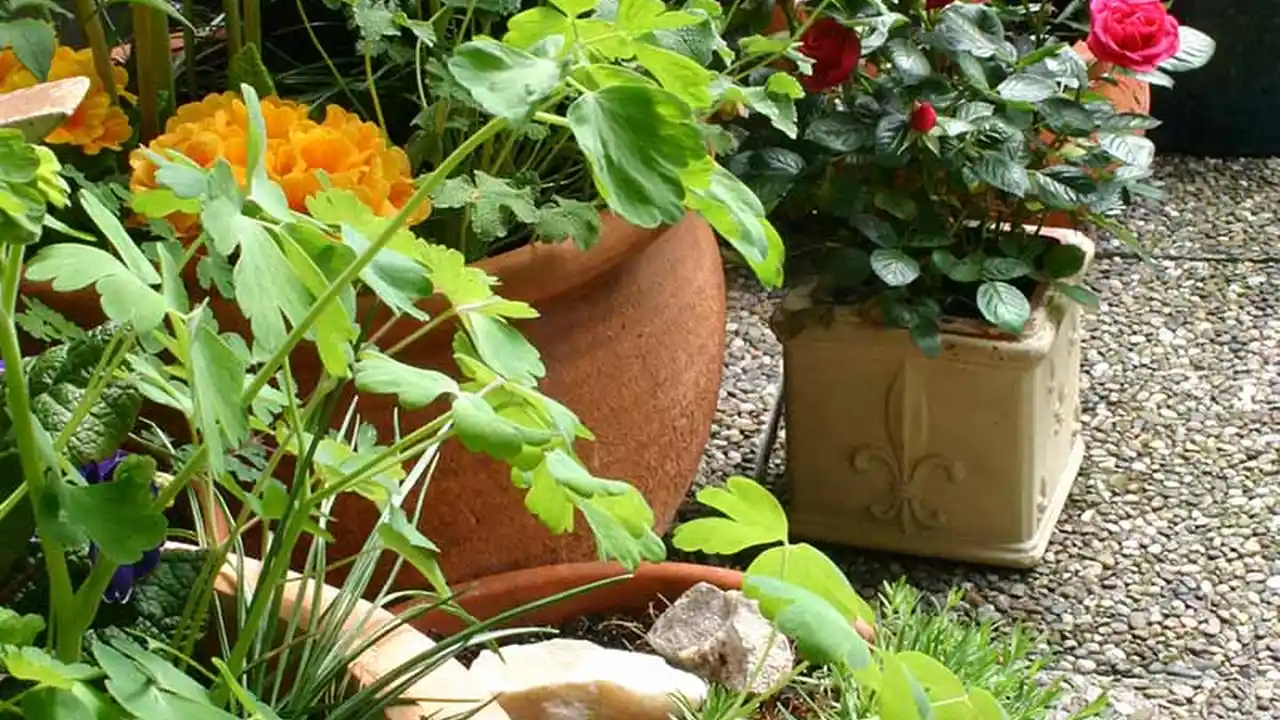Rainwater Harvesting for Your Garden 4 Simple Setups
Implement rainwater harvesting with these 4 simple setups. Conserve water and nourish your garden sustainably.

Rainwater Harvesting for Your Garden 4 Simple Setups
Hey there, fellow gardeners! Ever thought about how much precious water just runs off your roof and into the storm drains? It's a lot, and it's a shame to let it go to waste, especially when your garden could be thriving on it. Rainwater harvesting isn't just some eco-warrior trend; it's a smart, sustainable, and often cost-effective way to keep your plants happy and your water bill down. Plus, your plants actually prefer rainwater over treated tap water because it's free of chlorine and other chemicals. So, let's dive into four simple setups that can get you started on your rainwater harvesting journey, no matter your budget or DIY skill level.
Why Rainwater Harvesting Benefits Your Garden and Wallet
Before we get into the nitty-gritty of setups, let's quickly chat about why this is such a good idea. First off, it's about water conservation. In many areas, water resources are becoming scarcer, and using rainwater reduces your reliance on municipal supplies. This is especially crucial during dry spells or if you live in an area with water restrictions. Secondly, as mentioned, rainwater is better for your plants. It's naturally soft, pH-neutral, and free from the salts and chemicals found in tap water that can build up in your soil over time. This leads to healthier plants and better yields. Thirdly, it saves you money. Imagine cutting down your outdoor water usage significantly – that's real savings on your utility bill. And finally, it reduces stormwater runoff, which can help prevent erosion and pollution in local waterways. It's a win-win-win situation!
Setup 1 The Classic Rain Barrel A Beginner's Best Friend
This is probably the most common and easiest way to start harvesting rainwater. A rain barrel is essentially a large container placed under a downspout to collect water from your roof. It's perfect for small gardens, patios, or even just for watering your potted plants. You can buy pre-made kits or even DIY one from a food-grade barrel.
What You Need for a Rain Barrel Setup:
- Rain Barrel: Look for barrels specifically designed for rainwater harvesting. They usually come with a lid, a spigot near the bottom for attaching a hose, and an overflow spout. Sizes typically range from 50 to 100 gallons.
- Downspout Diverter Kit: This is a crucial component. It connects to your existing downspout and directs water into your rain barrel. When the barrel is full, it automatically diverts excess water back into the downspout.
- Level Base: A sturdy, level base (like concrete blocks or a wooden stand) to elevate the barrel. This provides enough pressure for water to flow out of the spigot and allows you to place a watering can underneath.
- Screen or Filter: Many barrels come with an integrated screen to keep out leaves, debris, and mosquitoes. If not, you'll want to add one.
How to Set Up a Rain Barrel:
- Choose a location near a downspout that's close to your garden or where you'll be using the water.
- Prepare a level, sturdy base for your barrel. Remember, a full 50-gallon barrel weighs over 400 pounds!
- Install the downspout diverter according to the manufacturer's instructions. This usually involves cutting a section out of your downspout.
- Place the barrel on its base and connect the diverter hose to the barrel's inlet.
- Ensure the overflow spout is directed away from your foundation or into another collection system.
Recommended Rain Barrel Products:
- Good: RTS Home Accents Impressions Rain Barrel (50-gallon): This is a popular choice for beginners. It looks like a traditional whiskey barrel, so it blends well into most landscapes. It comes with a brass spigot and a screen. Price: Around $120-$150.
- Better: Good Ideas Rain Wizard 65-Gallon Rain Barrel: A slightly larger capacity and often comes with a stand. It has a flat back to sit flush against your house. Price: Around $180-$220.
- Best: EarthMinded DIY Rain Barrel Kit (with FlexiFit Diverter): If you want to use your own food-grade barrel (like a pickle or olive barrel), this kit provides everything you need for the diverter and spigot. Price: Around $40-$60 (plus the cost of your barrel).
Usage Scenario: Perfect for watering small garden beds, container plants, or washing garden tools. Just attach a hose to the spigot or fill up a watering can. Remember to empty your barrel before freezing temperatures hit to prevent cracking.
Setup 2 Multiple Rain Barrels for Increased Capacity A Scalable Solution
If one rain barrel isn't enough for your watering needs, why not connect several? This is a simple way to increase your storage capacity without moving to a much larger, more complex system. You can link barrels together using a linking kit or by simply connecting their overflow spouts.
What You Need for Multiple Rain Barrels:
- Multiple Rain Barrels: As many as you need, ideally of the same height.
- Linking Kit or Hoses/Connectors: Many rain barrel brands offer linking kits. Otherwise, you'll need short sections of hose and appropriate connectors (like bulkhead fittings) to connect the barrels at their overflow or lower spigots.
- Sturdy, Level Base: Essential for all barrels.
- Downspout Diverter: One diverter can feed the first barrel, and then the water flows to the others.
How to Set Up Multiple Rain Barrels:
- Follow the steps for setting up a single rain barrel for your first barrel.
- Place subsequent barrels next to the first one, ensuring they are all on a level and sturdy base.
- Connect the barrels. The easiest way is to connect the overflow spout of the first barrel to the inlet of the second, and so on. Alternatively, you can connect them at a lower point using bulkhead fittings and hoses, which allows them to fill and drain more evenly.
- Ensure the final barrel in the series has its overflow directed away from your foundation.
Recommended Linking Products:
- Good: Specific Brand Linking Kits: If you buy barrels from the same brand (e.g., RTS Home Accents), they often have custom linking kits that are easy to install. Price: Around $20-$40 per kit.
- Better: Universal Rain Barrel Linking Kit: These kits often use flexible hoses and bulkhead fittings, allowing you to connect different types of barrels. Look for kits with durable, UV-resistant hoses. Price: Around $30-$50.
Usage Scenario: Ideal for medium-sized gardens, raised beds, or if you want to reduce your reliance on tap water for a significant portion of your outdoor watering. This setup provides more water for longer periods between rainfalls.
Setup 3 Large Capacity Tanks and Cisterns For Serious Water Savers
If you have a larger property, a big garden, or live in an area with significant water scarcity, you might consider a large capacity tank or cistern. These can hold hundreds or even thousands of gallons of water. They require more planning and a larger upfront investment but offer substantial water savings and independence.
What You Need for Large Capacity Tanks:
- Large Tank/Cistern: These come in various materials (polyethylene, fiberglass, concrete) and shapes (slimline, round, underground). Sizes can range from 200 gallons to over 5,000 gallons.
- First Flush Diverter: Essential for larger systems. This device diverts the initial dirty runoff from the roof (which contains leaves, dust, bird droppings) before clean water enters the main tank.
- Leaf Filter/Screen: To prevent larger debris from entering the system.
- Pump (Optional but Recommended): For larger tanks, a pump is often necessary to provide adequate water pressure for irrigation systems or longer hoses.
- Sturdy Foundation: A concrete pad or compacted gravel base is crucial for supporting the immense weight of a full tank.
- Professional Installation (Often Recommended): For very large or underground systems, professional help is advisable for proper sizing, plumbing, and safety.
How to Set Up a Large Capacity Tank:
- Site Selection: Choose a location that's level, accessible, and can support the weight. Consider proximity to downspouts and where you'll use the water.
- Foundation Preparation: Install a robust, level foundation.
- Gutter and Downspout Modification: Ensure your gutters are clean and properly sloped. Install a larger downspout if necessary to handle heavy rainfall.
- Install First Flush Diverter and Filters: These go between the downspout and the tank inlet.
- Connect Tank: Plumb the downspout to the tank's inlet.
- Install Overflow: Direct the overflow away from your foundation or into a drainage system.
- Install Pump (if using): Connect the pump to the tank's outlet and to your irrigation system or hose.
Recommended Large Tank Products:
- Good: Bushman Slimline Rainwater Tank (200-500 gallons): These are designed to fit against a wall, saving space. Made from durable polyethylene. Price: Around $500-$1,500 depending on size.
- Better: Norwesco Horizontal Leg Tanks (500-1000 gallons): Often used for agricultural purposes, these are very robust and can be placed on a flat surface. Price: Around $800-$2,000.
- Best: Custom Underground Cisterns: These are typically concrete or large plastic tanks buried underground, saving space and keeping water cool. Requires significant excavation and professional installation. Price: $3,000 - $10,000+ depending on size and complexity.
Usage Scenario: Ideal for irrigating large vegetable gardens, orchards, or even for non-potable indoor uses like flushing toilets (though this requires more advanced plumbing). Provides a significant buffer against drought conditions.
Setup 4 DIY Pond or Swale System A Natural Approach
This approach is less about collecting water in a container and more about directing and holding water in your landscape. It's a more natural, permaculture-inspired method that can help hydrate your garden beds and even recharge groundwater. This is great for larger properties with some natural slope.
What You Need for a Pond or Swale System:
- Shovel/Excavation Equipment: For digging the pond or swale.
- Pond Liner (for ponds): If you want a sealed pond to hold water.
- Leveling Tools: To ensure swales are on contour.
- Plants: Water-loving plants for the pond edges or along the swale.
- Mulch/Organic Material: To help retain moisture in swales.
How to Set Up a Pond or Swale System:
- Site Assessment: Observe how water flows on your property during a rain event. Identify areas where water naturally collects or flows.
- Design: For a pond, choose a low-lying area. For swales, identify a contour line (a line of equal elevation) across your landscape.
- Excavation: Dig your pond or swale. A swale is a ditch dug on contour with a berm (mound of earth) on the downhill side. The ditch collects water, and the berm helps it slowly infiltrate the soil.
- Lining (for ponds): If creating a pond, install a pond liner and secure it.
- Planting: Plant water-tolerant species around the pond or on the berm of the swale. These plants help stabilize the soil and absorb excess moisture.
- Mulching (for swales): Apply a thick layer of mulch to the swale ditch to reduce evaporation and encourage infiltration.
No Specific Products, but Key Concepts:
- Permaculture Design Principles: Understanding concepts like 'on contour' and 'keyline design' can greatly enhance the effectiveness of swales.
- Native Plants: Using native, water-wise plants around your pond or swale will help them thrive with minimal intervention.
- Heavy Duty Shovel: For manual digging, a good quality shovel like the Fiskars Ergo D-Handle Steel Garden Fork or a similar digging spade will be your best friend. Price: Around $40-$70.
- Pond Liner: For a small pond, a 20-mil PVC pond liner is a good start. Price: Varies greatly by size, but a 10x10 ft liner might be $50-$100.
Usage Scenario: Excellent for larger properties, creating a more resilient landscape, and supporting biodiversity. Swales are particularly good for hydrating fruit trees or larger garden beds over time, reducing the need for active irrigation. Ponds can create beautiful water features and habitats for wildlife.
Comparing the Setups Which One is Right for You?
Let's quickly compare these options to help you decide:
Rain Barrel vs. Multiple Barrels:
- Cost: Single barrel is cheapest. Multiple barrels increase cost but offer more storage.
- Complexity: Both are relatively simple DIY projects.
- Capacity: Single barrel (50-100 gallons) is good for small needs. Multiple barrels (100-500 gallons) suit medium gardens.
- Maintenance: Both require occasional cleaning and winterization.
Barrels vs. Large Tanks/Cisterns:
- Cost: Barrels are budget-friendly. Large tanks are a significant investment.
- Complexity: Barrels are easy DIY. Large tanks often require professional installation and plumbing.
- Capacity: Barrels are limited. Tanks offer massive storage (hundreds to thousands of gallons).
- Usage: Barrels are for manual watering. Tanks can be integrated into irrigation systems with pumps.
Container Systems vs. Pond/Swale Systems:
- Water Use: Container systems provide water for direct application. Pond/swale systems focus on landscape hydration and groundwater recharge.
- Space: Containers are compact. Ponds/swales require more land area.
- Maintenance: Containers need cleaning. Ponds/swales are more about ecological management.
- Aesthetics: Containers can be hidden or decorative. Ponds/swales become integrated landscape features.
Important Considerations for Any Rainwater System
No matter which setup you choose, keep these points in mind:
Local Regulations and Permits:
Some areas have regulations or even incentives for rainwater harvesting. Always check with your local municipality or homeowner's association before installing a system, especially larger ones. Some places might require permits or have specific guidelines on how water can be collected and used.
Water Quality and Usage:
Rainwater collected from your roof is generally good for irrigation. However, it's not typically considered potable (drinkable) without extensive filtration and treatment. Avoid using water from roofs with lead paint, asphalt shingles (especially new ones that can leach chemicals), or heavy moss/algae growth. Always use a screen to keep out debris and prevent mosquito breeding. If you plan to use it for edible plants, apply it to the soil, not directly on the leaves, especially if you're concerned about contaminants.
Maintenance is Key:
Regularly clean your gutters to prevent clogs and ensure clean water collection. Periodically inspect your diverters and filters. For barrels and tanks, drain and clean them annually to remove sediment buildup. In colder climates, remember to disconnect and drain your system before the first freeze to prevent damage from expanding ice.
Safety First:
Ensure your barrels or tanks are stable and cannot tip over, especially if you have children or pets. Elevate barrels on sturdy, level bases. If using pumps, ensure they are properly installed and grounded. For large systems, consider professional help for installation to ensure structural integrity and proper plumbing.
So, there you have it! Four simple ways to start harnessing the power of rain for your garden. Whether you begin with a single rain barrel or dream of a large cistern, every drop you collect makes a difference. Happy harvesting!
:max_bytes(150000):strip_icc()/277019-baked-pork-chops-with-cream-of-mushroom-soup-DDMFS-beauty-4x3-BG-7505-5762b731cf30447d9cbbbbbf387beafa.jpg)






